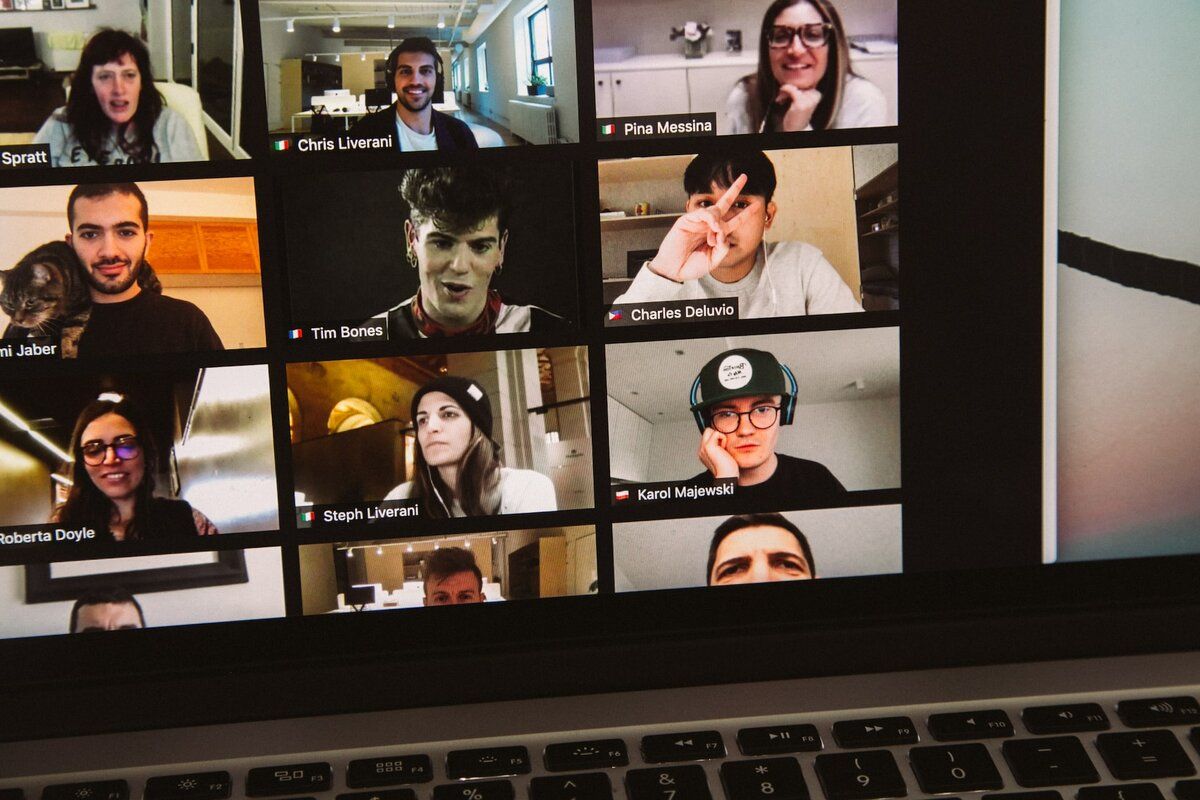Unless you’ve been living under a rock, you’ll have heard about the immense benefits to productivity and employee retention that come from a more comfortable and adaptive work environment. The 9-5, 40-hour work week is becoming a thing of the past, and companies and employees alike are embracing this change.
Hybrid environments are rapidly in increasing demand from employees and are so beneficial to worker well-being that some countries are considering remote work a human right.
So, how do you move from an in-house team building approach to a more favorable work-from-home environment? We’ve got some effective hybrid team building activities for you coming up. First, let’s talk about why it’s so important and yet so difficult to foster teamwork with remote teams.
Table of Contents
The Increasing Significance of Hybrid Team Building Activities

There’s an opportunity cost for every change in business, and the vast improvements to employee satisfaction, productivity, and retention that come with hybrid work environments generally outweigh any of the drawbacks associated with this change of approach.
And it is a necessary improvement to make; hybrid workforces are the new normal, and industry leaders are even fundamentally rethinking the hiring process with this in mind. Yet, these opportunity costs are worth identifying and considering, to see if there are ways to mitigate them.
While there is a difference between remote work and hybrid work, many of the drawbacks to either come from the remote side of both and one of the major difficulties in managing either team is their lack of physical presence among one another.
Peer-to-peer engagement comes traditionally from manufactured, physical team building exercises that involve people in the same place, working on the same solution to whichever problem is the focus of the exercise. With workers in different locations and on different in-office schedules, this proximity factor breaks down, and without a conscious effort to overcome this setback, team building becomes an opportunity cost.
How we handle these setbacks makes the difference between a fully-engaged team and one that loses the benefits of working together in person. It is possible to find workarounds for hybrid work models, and that’s the purpose of this article, but to see why they’re important, and how to maximize their effect, let’s look at some of the limitations of team building in the virtual world.

The Challenges and Limitations of Remote Work and Team Building Hybrid Workforces

The limitations of a hybrid workforce are many. Some are obvious, others are more insidious, and will take time to show themselves. All of them illuminate not only the importance of the role of team building in hybrid environments but help to illuminate solutions too.
Here are five things that hybrid workforces may struggle with:
- Isolation – This may show up early or late in the process of switching to hybrid work. Isolation comes naturally as many people spend less time in social environments. The benefits of hybrid work over remote work do make it possible to choose when to come in and when to stay at home, which goes some way to countering this limitation, however, the daily routine and familiar company of the office may not be present.
Team building hybrid workforces involves the need to address this risk of isolation before it becomes an issue, and this can be tricky. With everyone expecting different things and the unique needs of each individual, it’s impossible to find a one-size-fits-all solution to the problem, but there are ways to please the majority.
- Lack of culture and direction – With a disjointed routine, and a significant drop in the interaction between employees and the company they’re working in, there can be a loss in the engagement of employees with the company goals and culture.
Hybrid work physically distances people from the company, and this naturally leads to an emotionally distant workforce without some form of course correction. It is a difficult path to navigate to encourage interaction in a meaningful way when people aren’t in the same place, and a company runs the risk of having everyone on a different page without some intervention.
- Clumpy communication – Hybrid team building activities need to address the issue of communication, which can naturally devolve into silos if left unattended. With the use of private messages, remote workers can lose open communication channels, and collaboration is naturally reduced.
- Slow burnout – It has been shown that the effects of isolation aren’t always obvious. Sometimes, workers can choose to spend more time remotely and will benefit from the alone time initially, but over time, the lack of social interaction can cause a mental strain that creeps up so slowly, that the solution isn’t as obvious as it should be.
Team building for hybrid work, therefore, needs to address issues that the workers themselves are not always aware of, and this can be tricky without face-to-face communication channels open.
- Misunderstandings – Text-based communication is notorious for being easy to misread. A rushed text that forgets the ‘please’, or a polite request that doesn’t take into account the tone of the message can foster hostility and drops in teamwork.
Team building needs to focus on these potential issues before they arise, and look out for areas for improvement of communication in a realm where directly speaking to the people involved isn’t always as simple as calling them into an office for a chat.
There are many other ways that hybrid work can become at odds with teamwork, but fortunately, with a bit of planning and foresight, all of these issues can be addressed early on, and hybrid team building activities can be just as effective as those held in person.
For some inspiration, we’ve compiled a list of ten such activities.
Ten Hybrid Event Ideas and Remote Working Activities

There are so many ways to engage people in hybrid work programs. Each of these ideas is a suggestion aimed to counter some of the limitations we talked about above, and bring increased engagement and recreation to teams working in discrete locations.
1. Run polls – polls are a great and simple way to bring people together. They’re so diverse in the range of things they can cover, they can be hilarious or informative, and they can even help management keep their finger on the pulse of the group to make sure everyone is engaged and content.
Making the poll about something company-related also helps to align the goals of the team to that of the business as a whole, which can be an added benefit all around. Polls can be replaced or supplemented with quizzes for a slightly competitive approach, and this gives the opportunity for rewards to be earned for engagement.
2. Run learning sessions – Interactive training sessions are a good way to combine team building with on-the-job training or life skills. These can be held online, as part of a series of seminars, or casually as a live team discussion.
One of the ways this routine approach to learning is valuable is in the diversity of topics you can cover. Training can switch between practical and informal, such as updates on testing methodologies in the first week, and a guest talk on classical mythology the next.
The point of this one is less to impart information in a formal setting, and more to do with bringing people together to learn as a group, so the more casual and interactive it is, the better.
3. Share your targets – Having a forum in which employees can post their daily or weekly targets serves two purposes. First of all, it promotes accountability; the goal is now public, so there’s external pressure to reach it. Secondly, it brings people in the team together with the sense that everyone is working hard to attain something.
These targets don’t even have to be work-related. In fact, there is an added benefit to team building if they’re entirely personal. Providing an insight into people’s personal lives like this replicates the office chat that might occur more naturally between colleagues in the office, and provides the same bonding effect.
4. Play games – Quizzes naturally lend themselves to a virtual environment but there are countless other interactive games and fun tasks available to remote and hybrid teams too. Giving out clues throughout the week for a murder mystery game, or starting a GIF war are two possible ways to get people interacting.
The more collaborative the game, the better, so look around for some good ideas or ask the team for suggestions.
5. Get to know – Create a questionnaire-based investigation into how well your team knows one another. Everyone can contribute information about themselves and send it in, then they get assigned a colleague to answer for, and see how many facts they get right.
Depending on how close the teams are, this can be made easier by turning it into a multiple-choice question, with two wrong answers and one right one. Working through these publicly can bring a lot of laughs and people get to know interesting things about one another too.
6. Virtual lunch break – This can be a routine event that involves people synchronizing their breaks and contributing a comment or a picture of their lunch. Some of the contributions will be funny, some will be impressive, and the opportunity to be creative allows for some personality to shine through. It’s also a way for people to get chatty over their lunch, just as they would in the office, and can foster connections that are unrelated to work.
7. Set up a book club – This should be a simple one to set up. It’s just a matter of scheduling a time frame, selecting a book, and recruiting members. Then, hold a meeting to discuss the elements of the book that they found interesting. This event can fit around work, it can be inclusive of anyone who wishes to join, and it doesn’t have to take a lot of time, so it can be held concurrently with other hybrid team building activities you may have lined up.
8. Movie nights – Similar to the book club, but even easier! One night a week, or month, or on whichever schedule suits your team, have a shared screening of a movie. There are several ways to host a virtual watch party, and members can either vote on the movies they want to watch, or they can be chosen from a list of diverse and hand-picked cinema options for more adventurous viewers. Between viewings, there can be an opportunity to discuss the previous movie, and what people felt about it.
9. Video games nights – Console owners can come together for online gaming, facilitated by the company. However, many people may not have access to the same platforms, so setting up a games night based around the laptops and home computers your workers will be using is a better way to be inclusive. Games nights can be split into different gaming styles, competitions, or tournaments, and can be held at any level.
10. Bring people in! – It’s important to remember that hybrid work isn’t fully remote. If there’s a point on the calendar when people will be mostly in the same room, consider throwing a classic team builder on that day. Otherwise, put in a request for members to show up for a face-to-face. You might find that there are several people who haven’t bumped into one another for a while and are happy to reconnect, and others who have only heard someone’s voice and are excited to put a face to it. A simple get-together goes a long way to team building when teams aren’t always in the same place, but you can of course throw in some classic in-office team building activities if you want to.
This list of hybrid event ideas should go some way to inspiring your own hybrid work activities for team building, but if you’re still a little unsure, check out our best practices.
Hybrid Team Building Best Practices
If you’re not sure where to go with your hybrid team building activities, and the list above doesn’t quite fill the gap, it’s reasonably simple to set up your own. All you have to keep in mind are a few best practices. The essence of a good remote or hybrid event idea is something that appeals to the most amount of people, in a way that aligns their goals with one another and the company. Here’s a look at some best practices to help you create your own:
- Offer a choice – It’s not going to work out if you try to force people into your event. Connections and engagement have to come naturally; the event merely facilitates it by creating the space and the opportunity for people to come together. For regular events, make sure the choice is always there, even if people haven’t joined in prior.
- Make it about the company – Where possible, team building should be about corresponding the efforts of the workforce with the goals of the company. This can be done in some ways by factoring in relevant training or work-related quizzes, as mentioned above, as long as there is a good balance. Which leads us to the next tip:
- Don’t make it all about the company – Engagement has to come from the shared experiences of the people involved, and from individuals seeing one another as people. If you focus too heavily on work-related exercises, you’ll only be fostering an attitude that everyone is an employee, and you’ll be missing out on the personal touch.
- Make sure representatives are personally present – Management needs to show up. This doesn’t have to be in-person, but it should be one-to-one, where possible. As much as it’s important for team members to work with one another, it’s also important to foster the sense that the company and the employees are all on the same team. Do this by making personal contact, making sure everyone is accounted for, and personally congratulating or commenting on the attendees of events.
CultureBot offers an integrated solution that promotes company culture among remote and hybrid teams. This slack app makes recognition simple and effective and promotes peer-to-peer communication and encouragement. Factoring this into your team building efforts opens up a bunch of options for motivating and engaging employees and building collaboration with peer reward points and shoutouts.
- Integrate and unify communications – This is a general practice that facilitates better teamwork, rather than one that’s only relevant to events. More open communication and more accessible information will help to counter the communication silos that may form from remote work. Try to have a unified hub of communication to prevent misalignments or miscommunications from arising.

Conclusion
As you can see, there are a lot of ways to approach team building for hybrid workers. Perhaps more important than the idea suggestions themselves is the understanding of hybrid work limitations when it comes to team building, and the best practices to overcome them.
With a little forethought, some effort, and by taking advantage of the new communications and work-from-home technologies, your team building efforts for your hybrid teams should be no less effective than the in-house activities you’re used to.
???? Stay happy & healthy,
~ Amy





